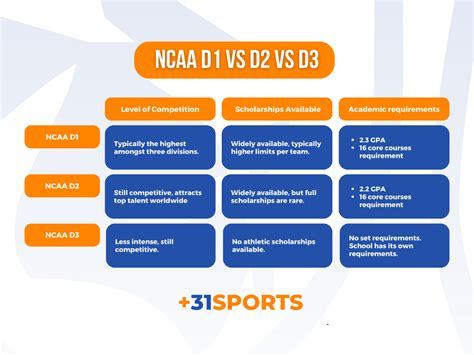Introduction
In the realm of collegiate athletics, the terms D1, D2, and D3 are frequently used to categorize sports programs. These designations play a significant role in determining the level of competition, funding, and visibility that a program enjoys. Understanding the differences between these divisions is crucial for athletes, coaches, and fans alike.

D1: Division I
D1 is the highest level of collegiate athletics, representing the most elite sports programs in the country. It is home to renowned universities such as Duke, Ohio State, and Alabama. D1 programs have the largest budgets, attract the top recruits, and compete in high-profile tournaments and championships.
Key Characteristics:
- Athletic Scholarships: D1 programs offer full athletic scholarships to eligible student-athletes.
- Large Budgets: D1 programs boast substantial financial resources, allowing for state-of-the-art facilities, coaching salaries, and support services.
- National Coverage: D1 sports receive extensive national media coverage, including television, radio, and print outlets.
D2: Division II
D2 is the second-highest level of collegiate athletics, offering a balance between academic and athletic excellence. It includes universities such as Grand Valley State, Queens College, and Saint Leo University. D2 programs provide high-quality competition while also emphasizing academic achievement.
Key Characteristics:
- Partial Athletic Scholarships: D2 programs offer partial athletic scholarships, allowing student-athletes to offset the cost of tuition and expenses.
- Medium Budgets: D2 programs have smaller budgets than D1 programs, but they still provide competitive facilities and support services.
- Regional Competition: D2 sports primarily compete within regional conferences, with some national tournaments available.
D3: Division III
D3 is the third and final level of collegiate athletics, focusing on academic pursuits above athletic achievements. It includes institutions such as MIT, Amherst College, and Emory University. D3 programs value intercollegiate competition while maintaining a strong emphasis on education.
Key Characteristics:
- No Athletic Scholarships: D3 programs do not offer any athletic scholarships. Students are solely responsible for covering the cost of tuition and other expenses.
- Limited Budgets: D3 programs have modest budgets, often relying on student fees and fundraising to support their athletic programs.
- Local Competition: D3 sports primarily compete within regional conferences, with a few national championship events held.
Key Differentiators
| Division | Athletic Scholarships | Budget | National Coverage | Focus |
|---|---|---|---|---|
| D1 | Full | Large | Extensive | Athletics |
| D2 | Partial | Medium | Regional | Balance |
| D3 | None | Modest | Local | Education |
Impact on Athletes
The D1, D2, and D3 designations have a significant impact on the experiences of college athletes.
D1: D1 athletes compete at the highest level, with the potential for national recognition and professional opportunities. They enjoy access to elite facilities, top-notch coaching, and professional-quality support services. However, the pressure to succeed and the time commitment required can be overwhelming.
D2: D2 athletes balance athletic and academic pursuits, enjoying a less stressful environment than D1. They have the opportunity to compete at a high level while pursuing their educational goals. Financial assistance through partial scholarships can alleviate financial burdens.
D3: D3 athletes prioritize academic achievement, participating in sports as a complement to their studies. They enjoy a balanced lifestyle, with less pressure and more time for other activities. However, they may not have the same level of athletic facilities or support services as D1 and D2 programs.
Impact on Programs
The D1, D2, and D3 designations also impact the institutions that host sports programs.
D1: D1 programs bring national recognition and revenue to their universities. They require significant investment in facilities, coaching salaries, and support staff. However, the potential for success and the increased visibility can boost enrollment and enhance the institution’s overall reputation.
D2: D2 programs provide a balance between athletics and academics, offering opportunities for student-athletes to excel in both areas. They foster a sense of community and pride within their institutions while also generating revenue through ticket sales and alumni donations.
D3: D3 programs emphasize academic excellence and student development. They enhance the institution’s overall educational mission and create a well-rounded campus culture. D3 programs often rely on alumni support and fundraising to supplement their limited budgets.
Conclusion
The D1, D2, and D3 designations in sports serve as a way to categorize programs based on their level of competition, funding, and emphasis on academics. Each division offers unique opportunities and challenges for athletes, programs, and institutions alike. Understanding the distinctions between these divisions is essential for maximizing the student-athlete experience and ensuring that sports continue to play a positive role in higher education.
